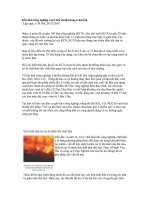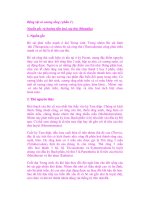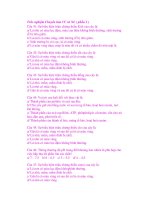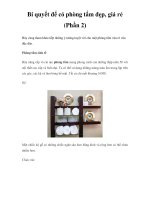Compact Summary of VHDL phần 2 pps
Bạn đang xem bản rút gọn của tài liệu. Xem và tải ngay bản đầy đủ của tài liệu tại đây (258.82 KB, 10 trang )
The default is in .
The reserved word function may be preceded by nothing,
implying pure , pure or impure .
A pure function must not contain a reference to a file object,
slice, subelement, shared variable or signal with attributes
such as 'delayed, 'stable, 'quiet, 'transaction and must not
be a parent of an impure function.
Function Body
Used to define the implementation of the function.
function identifier [ ( formal parameter list ) ]
return a_type is
[ declarations, see allowed list below ]
begin
sequential statement(s)
return some_value; of type a_type
end function identifier ;
function random return float is
variable X : float;
begin
compute X
return X;
end function random ;
The function body formal parameter list is defined above in
Function Declaration. When a function declaration is used then
the corresponding function body should have exactly the same
formal parameter list.
The allowed declarations are:
subprogram declaration
subprogram body
type declaration
subtype declaration
constant, object declaration
variable, object declaration
file, object declaration
alias declaration
use clause
group template declaration
group declaration
Declarations not allowed include:
signal, object declaration
Context Clause
Used to name a library and make library units visible
to the design unit that immediately follows.
VHDL Design Units and Subprograms
(9 of 11) [22/12/2001 15:23:35]
library library_name ;
use library_name.unit_name.all ;
library STD ;
use STD.textio.all;
library ieee ;
use ieee.std_logic_1164.all;
use ieee.std_logic_textio.all;
use ieee.std_logic_arith.all;
use ieee.numeric_std.all;
use ieee.numeric_bit.all;
use WORK.my_pkg.s_inc; select one item from package
Note that the .all makes everything visible. It is
optional and when not used the prefix such as
ieee.std_logic_1164. must be used on every reference
to an item in the library unit. Specific items in the
library unit may be listed in place of .all .
The libraries STD and WORK do not need a library specification
on most systems. library ieee or equivalent library IEEE
is needed on most systems.
Order of Analysis, Compilation
Every design unit must be analyzed, compiled, before it can
be used by another design unit. The result of the analysis
or compilation results in an analyzed design in a library.
The analyzed design goes into the default library WORK
unless otherwise specified.
An entity must be analyzed, compiled, before its corresponding
architectures or configurations.
A package declaration must be analyzed, compiled, before its
corresponding package body.
A package declaration must be analyzed, compiled, before it can
be referenced in a context clause. For example:
Analyze, compile
package my_package is
declarations
end package my_package;
then analyze, compile
library WORK; this line usually not needed
use WORK.my_package.all
entity my_entity is
entity stuff
end entity my_entity;
VHDL Design Units and Subprograms
(10 of 11) [22/12/2001 15:23:35]
Other Links
VHDL help page●
Hamburg VHDL Archive (the best set of links I have seen!)●
RASSP Project VHDL Tools●
VHDL Organization Home Page●
gnu GPL VHDL for Linux, under development●
More information on Exploration/VHDL from FTL Systems.●
Go to top
Go to VHDL index
VHDL Design Units and Subprograms
(11 of 11) [22/12/2001 15:23:35]
|Summary |Design Units |Sequential Statements |Concurrent Statements |Predefined Types |Declarations |
|Resolution and Signatures |Reserved Words |Operators |Predefined Attributes |Standard Packages |
VHDL Sequential Statements
These statements are for use in Processes, Procedures and Functions.
The signal assignment statement has unique properties when used sequentially.
Sequential Statements
wait statement●
assertion statement●
report statement●
signal assignment statement●
variable assignment statement●
procedure call statement●
if statement●
case statement●
loop statement●
next statement●
exit statement●
return statement●
null statement●
wait statement
Cause execution of sequential statements to wait.
[ label: ] wait [ sensitivity clause ] [ condition clause ] ;
wait for 10 ns; timeout clause, specific time delay.
wait until clk='1'; condition clause, Boolean condition
wait until A>B and S1 or S2; condition clause, Boolean condition
wait on sig1, sig2; sensitivity clause, any event on any
signal terminates wait
assertion statement
Used for internal consistency check or error message generation.
[ label: ] assert boolean_condition [ report string ] [ sensitivity name ] ;
assert a=(b or c);
assert j<i report "internal error, tell someone";
assert clk='1' report "clock not up" sensitivity WARNING;
VHDL Sequential Statements
(1 of 6) [22/12/2001 15:23:36]
predefined sensitivity names are: NOTE, WARNING, ERROR, FAILURE
default sensitivity for assert is ERROR
report statement
Used to output messages.
[ label: ] report string [ sensitivity name ] ;
report "finished pass1"; default sensitivity name is NOTE
report "Inconsistent data." sensitivity FAILURE;
signal assignment statement
The signal assignment statement is typically considered a concurrent
statement rather than a sequential statement. It can be used as
a sequential statement but has the side effect of obeying the
general rules for when the target actually gets updated.
In particular, a signal can not be declared within a process or
subprogram but must be declared is some other appropriate scope.
Thus the target is updated in the scope where the target is declared
when the sequential code reaches its end or encounters a 'wait'
or other event that triggers the update.
[ label: ] target <= [ delay_mechanism ] waveform ;
delay_mechanism
transport
reject time_expression
inertial
waveform
waveform_element [, waveform_element]
unaffected
waveform_element
value_expression [ after time_expression ]
null [ after time_expression ]
sig1 <= sig2;
Sig <= Sa and Sb or Sc nand Sd nor Se xor Sf xnor Sg;
sig1 <= sig2 after 10 ns;
clk <= '1' , '0' after TimePeriod/2 ;
sig3 <= transport sig4 after 3 ns;
sig4 <= reject 2 ns sig5 after 3 ns; increasing time order
sig6 <= inertial '1' after 2 ns, '0' after 3 ns , '1' after 7 ns;
Note: omitting [ after time_expression ] is equivalent
to after 0 fs;
VHDL Sequential Statements
(2 of 6) [22/12/2001 15:23:36]
More information in Concurrent Statements signal assignment statement.
variable assignment statement
Assign the value of an expression to a target variable.
[ label: ] target := expression ;
A := -B + C * D / E mod F rem G abs H;
Sig := Sa and Sb or Sc nand Sd nor Se xor Sf xnor Sg;
procedure call statement
Call a procedure.
[ label: ] procedure-name [ ( actual parameters ) ] ;
do_it; no actual parameters
compute(stuff, A=>a, B=>c+d); positional association first,
then named association of
formal parameters to actual parameters
if statement
Conditional structure.
[ label: ] if condition1 then
sequence-of-statements
elsif condition2 then \_ optional
sequence-of-statements /
elsif condition3 then \_ optional
sequence-of-statements /
else \_ optional
sequence-of-statements /
end if [ label ] ;
if a=b then
c:=a;
elsif b<c then
d:=b;
b:=c;
else
do_it;
end if;
VHDL Sequential Statements
(3 of 6) [22/12/2001 15:23:36]
case statement
Execute one specific case of an expression equal to a choice.
The choices must be constants of the same discrete type as the expression.
[ label: ] case expression is
when choice1 =>
sequence-of-statements
when choice2 => \_ optional
sequence-of-statements /
when others => \_ optional if all choices covered
sequence-of-statements /
end case [ label ] ;
case my_val is
when 1 =>
a:=b;
when 3 =>
c:=d;
do_it;
when others =>
null;
end case;
loop statement
Three kinds of iteration statements.
[ label: ] loop
sequence-of-statements use exit statement to get out
end loop [ label ] ;
[ label: ] for variable in range loop
sequence-of-statements
end loop [ label ] ;
[ label: ] while condition loop
sequence-of-statements
end loop [ label ] ;
loop
input_something;
exit when end_file;
end loop;
for I in 1 to 10 loop
AA(I) := 0;
end loop;
VHDL Sequential Statements
(4 of 6) [22/12/2001 15:23:36]
while not end_file loop
input_something;
end loop;
all kinds of the loops may contain the 'next' and 'exit' statements.
next statement
A statement that may be used in a loop to cause the next iteration.
[ label: ] next [ label2 ] [ when condition ] ;
next;
next outer_loop;
next when A>B;
next this_loop when C=D or done; done is a Boolean variable
exit statement
A statement that may be used in a loop to immediately exit the loop.
[ label: ] exit [ label2 ] [ when condition ] ;
exit;
exit outer_loop;
exit when A>B;
exit this_loop when C=D or done; done is a Boolean variable
return statement
Required statement in a function, optional in a procedure.
[ label: ] return [ expression ] ;
return; from somewhere in a procedure
return a+b; returned value in a function
null statement
Used when a statement is needed but there is nothing to do.
[ label: ] null ;
null;
VHDL Sequential Statements
(5 of 6) [22/12/2001 15:23:36]
Other Links
VHDL help page●
Hamburg VHDL Archive (the best set of links I have seen!)●
RASSP Project VHDL Tools●
VHDL Organization Home Page●
gnu GPL VHDL for Linux, under development●
More information on Exploration/VHDL from FTL Systems.●
Go to top
Go to VHDL index
VHDL Sequential Statements
(6 of 6) [22/12/2001 15:23:36]
|Summary |Design Units |Sequential Statements |Concurrent Statements |Predefined Types |Declarations |
|Resolution and Signatures |Reserved Words |Operators |Predefined Attributes |Standard Packages |
VHDL Concurrent Statements
These statements are for use in Architectures.
Concurrent Statements
block statement●
process statement●
concurrent procedure call statement●
concurrent assertion statement●
concurrent signal assignment statement●
conditional signal assignment statement●
selected signal assignment statement●
component instantiation statement●
generate statement●
block statement
Used to group concurrent statements, possibly hierarchically.
label : block [ ( guard expression ) ] [ is ]
[ generic clause [ generic map aspect ; ] ]
[ port clause [ port map aspect ; ] ]
[ block declarative items ]
begin
concurrent statements
end block [ label ] ;
clump : block
begin
A <= B or C;
D <= B and not C;
end block clump ;
maybe : block ( B'stable(5 ns) ) is
port (A, B, C : inout std_logic );
port map ( A => S1, B => S2, C => outp );
constant delay: time := 2 ns;
signal temp: std_logic;
begin
temp <= A xor B after delay;
C <= temp nor B;
end block maybe;
VHDL Concurrent Statements
(1 of 6) [22/12/2001 15:23:36]









